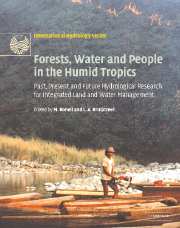 Forests, Water and People in the Humid Tropics
Forests, Water and People in the Humid Tropics Book contents
- Frontmatter
- Contents
- List of contributors
- Foreword
- Preface
- Acknowledgements
- Symposium and Workshop
- Introduction
- Part I Current trends and perspectives on people–land use–water issues
- 1 Trends and patterns of tropical land use change
- 2 The myth of efficiency through market economics: a biophysical analysis of tropical economies, especially with respect to energy, forests and water
- 3 Impacts of land cover change in the Brazilian Amazon: a resource manager's perspective
- 4 Forest people and changing tropical forestland use in tropical Asia
- 5 People in tropical forests: problem or solution?
- 6 Useful myths and intractable truths: the politics of the link between forests and water in Central America
- 7 Land use, hydrological function and economic valuation
- 8 Water resources management policy responses to land cover change in South East Asian river basins
- 9 Community-based hydrological and water quality assessments in Mindanao, Philippines
- Part II Hydrological processes in undisturbed forests
- Part III Forest disturbance, conversion and recovery
- Part IV New methods for evaluating effects of land-use change
- Part V Critical appraisals of best management practices
- Conclusion: Forests, water and people in the humid tropics: an emerging view
- Plate section
- References
2 - The myth of efficiency through market economics: a biophysical analysis of tropical economies, especially with respect to energy, forests and water
from Part I - Current trends and perspectives on people–land use–water issues
Published online by Cambridge University Press: 12 January 2010
- Frontmatter
- Contents
- List of contributors
- Foreword
- Preface
- Acknowledgements
- Symposium and Workshop
- Introduction
- Part I Current trends and perspectives on people–land use–water issues
- 1 Trends and patterns of tropical land use change
- 2 The myth of efficiency through market economics: a biophysical analysis of tropical economies, especially with respect to energy, forests and water
- 3 Impacts of land cover change in the Brazilian Amazon: a resource manager's perspective
- 4 Forest people and changing tropical forestland use in tropical Asia
- 5 People in tropical forests: problem or solution?
- 6 Useful myths and intractable truths: the politics of the link between forests and water in Central America
- 7 Land use, hydrological function and economic valuation
- 8 Water resources management policy responses to land cover change in South East Asian river basins
- 9 Community-based hydrological and water quality assessments in Mindanao, Philippines
- Part II Hydrological processes in undisturbed forests
- Part III Forest disturbance, conversion and recovery
- Part IV New methods for evaluating effects of land-use change
- Part V Critical appraisals of best management practices
- Conclusion: Forests, water and people in the humid tropics: an emerging view
- Plate section
- References
Summary
INTRODUCTION
Tropical countries, in general, are changing much more rapidly than temperate ones. This is true with respect to population numbers, deforestation, economic growth (both positive and, occasionally, negative), influence of trade and, in general, various other aspects of globalisation (World Bank, 1998). At the same time, most tropical countries remain especially vulnerable to both natural and man-made disasters (Hurricane Mitch in Central America and the 1998 Asian economic ‘meltdown’ serve as ready examples). Within this context of uncertainty, ‘sustainability’ remains an obvious and highly desired goal for many, as is obvious in the promotional tourist literature of many tropical countries, such as Costa Rica. Similarly, one hears from various quarters the desirability of improving ‘efficiency’ and also the concept that with high levels of development, environmental improvements are not only possible but likely (e.g. the environmental Kuznets curve; see Rothman and de Bruyn, 1998). Often these are seen as important rationales for far-reaching programmes, such as the structural adjustment programmes implemented in many tropical countries by the World Bank and the International Monetary Fund (Lélé, 1991; Taylor, 1993) and even for large-scale conservation programmes (Goodland et al., 1990).
The concept of sustainability
What would constitute this sustainability, if indeed it were able to be achieved?
- Type
- Chapter
- Information
- Forests, Water and People in the Humid TropicsPast, Present and Future Hydrological Research for Integrated Land and Water Management, pp. 40 - 58Publisher: Cambridge University PressPrint publication year: 2005
References
- 4
- Cited by


